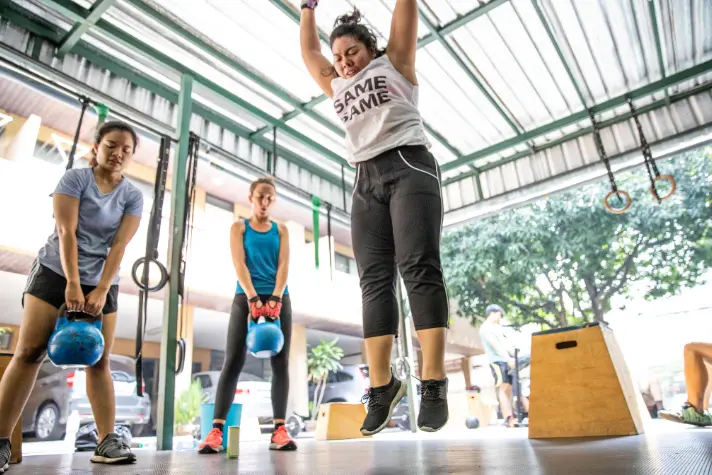
Exercise is a crucial part of a healthy lifestyle, offering numerous benefits for both physical and mental well-being. However, it’s important to remember that injuries can happen, and they can be a significant setback on your fitness journey.
In the hustle and bustle of modern living, where we often push ourselves to achieve fitness goals and maintain an active lifestyle, safeguarding our well-being becomes paramount.
The pursuit of physical fitness and health is indeed a noble endeavor, but it should not come at the cost of injury or long-term damage. In the quest for fitness and athletic performance, injury prevention is often a top concern. Nobody wants to be sidelined due to an injury, and that’s where cross-training comes into play.
While specialized training routines can undoubtedly yield impressive results, they may also increase the risk of overuse injuries. Cross-training, on the other hand, offers a well-rounded approach that not only enhances performance but also reduces the likelihood of getting hurt.
Fortunately, with the right precautions and awareness, you can minimize the risk of injuries during exercise.
So what is cross-training?

Cross-training is a fitness strategy that involves engaging in a variety of exercises and activities beyond your primary sport or workout routine. It’s all about diversifying your physical training to work different muscle groups, improve overall fitness, and reduce the risk of overuse injuries. This approach is particularly popular among athletes and fitness enthusiasts looking to enhance their performance and maintain a well-rounded physical condition.
What are the benefits of Cross-Training?
Reduced Risk of Overuse Injuries
According to a known physiotherapy clinic, one of the most significant benefits of cross-training is its ability to prevent overuse injuries. When you constantly repeat the same movements or engage the same muscle groups, you’re at a higher risk of straining or damaging those specific areas. Cross-training introduces variety into your workouts, giving those overused muscles a break and allowing others to strengthen and recover.
Enhanced Fitness
Cross-training engages different energy systems and muscle groups, leading to improved overall fitness. Whether you’re a runner, a cyclist, or a weightlifter, incorporating activities like swimming, yoga, or resistance training can help you build strength, flexibility, and endurance in areas you might be neglecting in your primary sport.
Improved Performance
Surprisingly, cross-training can have a positive impact on your primary sport or fitness activity. By enhancing your overall fitness and addressing weaknesses, you can potentially perform better and more efficiently. For example, a runner who cross-trains with strength exercises may experience improved running form and increased speed.
Mental Refreshment
Doing the same workout day in and day out can lead to burnout and mental fatigue. Cross-training offers a mental break from monotony, making your fitness journey more enjoyable and sustainable in the long run.
Getting Started with Cross-Training

Incorporating cross-training into your fitness routine doesn’t have to be complicated. Here are some steps to get you started:
Identify Weaknesses: Assess your strengths and weaknesses to determine which areas of your fitness need improvement.
Choose Complementary Activities: Select activities that complement your primary sport or workout routine. For example, if you’re a runner, consider swimming or cycling.
Create a Schedule: Incorporate cross-training sessions into your weekly routine. Aim for at least one or two days a week.
Listen to Your Body: Pay attention to how your body responds to cross-training. If an activity causes pain or discomfort, consider modifying or replacing it.
Seek Guidance: Consult with a healthcare professional to create a well-balanced cross-training plan tailored to your goals and needs.
Injury prevention is a critical aspect of any fitness journey, and cross-training has emerged as a valuable tool in achieving that goal. By diversifying your workouts, you reduce the risk of overuse injuries improve your overall fitness, and enhance your performance in your primary sport or activity.
So, unleash the role of cross-training and take your fitness to new heights while keeping injuries at bay. Your body will thank you for it.
Contributed by:
HealthMax Physiotherapy Clinic is a leading healthcare provider located in the heart of the Greater Toronto Area. With a dedicated team of experienced physiotherapists and healthcare professionals, our clinic is committed to enhancing the well-being and quality of life of individuals in our community.
Reference:
• Physical training: methods and effects.
Fox EL.Orthop Clin North Am. 1977 Jul;8(3):533-48.PMID: 329173 Review. No abstract available.
• The Effect of Periodization and Training Intensity Distribution on Middle- and Long-Distance Running Performance: A Systematic Review.
Kenneally M, Casado A, Santos-Concejero J.Int J Sports Physiol Perform. 2018 Oct 1;13(9):1114-1121. doi: 10.1123/ijspp.2017-0327. Epub 2018 Oct 18.PMID: 29182410 Review.
• Evaluation principles for health care training institutions: the basics.
Benjamin S.J Healthc Educ Train. 1992;7(1):7-12.PMID: 10120541 Review. No abstract available.
• Long-Term Development of Training Characteristics and Performance-Determining Factors in Elite/International and World-Class Endurance Athletes: A Scoping Review.
Staff HC, Solli GS, Osborne JO, Sandbakk Ø.Sports Med. 2023 Aug;53(8):1595-1607. doi: 10.1007/s40279-023-01850-z. Epub 2023 May 13.PMID: 37178349 Free PMC article.
• The impact of cross-training on team functioning: an empirical investigation.
Volpe CE, Cannon-Bowers JA, Salas E, Spector PE.Hum Factors. 1996 Mar;38(1):87-100. doi: 10.1518/001872096778940741.PMID: 8682521 Clinical Trial.
• Effects of Cross-Training on Medical Teams’ Teamwork and Collaboration: Use of Simulation.
Hedges AR, Johnson HJ, Kobulinsky LR, Estock JL, Eibling D, Seybert AL.Pharmacy (Basel). 2019 Jan 19;7(1):13. doi: 10.3390/pharmacy7010013.PMID: 30669460 Free PMC article.
• Cross training: possible mechanisms for the contralateral effects of unilateral resistance training.
Lee M, Carroll TJ.Sports Med. 2007;37(1):1-14. doi: 10.2165/00007256-200737010-00001.PMID: 17190532 Review.




